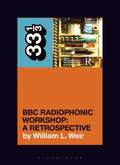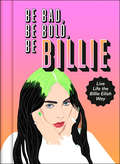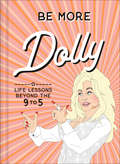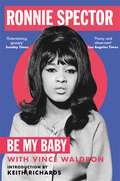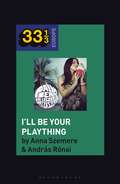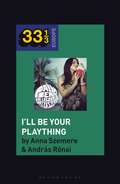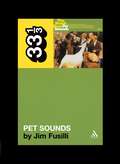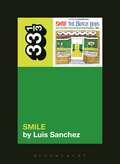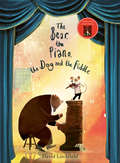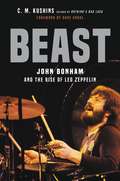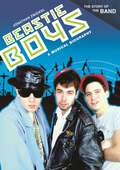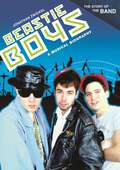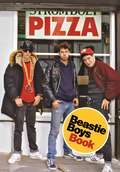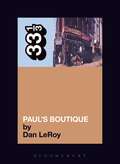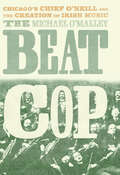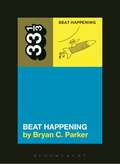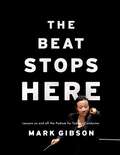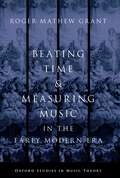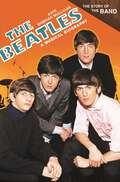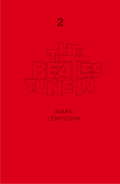- Table View
- List View
BBC Radiophonic Workshop's BBC Radiophonic Workshop - A Retrospective (33 1/3)
by William L. WeirIn 1958, an anonymous group of overworked and under-budgeted BBC employees set out to make some new sounds for radio and TV. They ended up changing the course of 20th-century music. For millions of people, the work of the BBC Radiophonic Workshop was the first electronic music they had ever heard. Sampling, loops, and the earliest synthesizers-long before audiences knew what they were-made up the groundbreaking scores for news programs, auto maintenance shows, and children's programming. They also produced the Doctor Who theme, one of the first electronic music masterpieces. The Beatles, Pink Floyd, and others borrowed from them. A generation of musicians raised on BBC programming-Aphex Twin, Portishead, and Prodigy among them-took these once-alien sounds and carried on the Workshop's legacy. Ignored for decades by music historians, the Workshop is now recognized as one of the most influential forebears of electronica, psychedelia, ambient music, and synth-pop.
Be Bad, Be Bold, Be Billie: Live Life The Billie Eilish Way
by Scarlett Russell**THE PERFECT GIFT FOR BILLIE EILISH FANS** A celebration of Billie Eilish's refreshing outlook, creativity and independence. We all want a bit more Billie in our lives!
Be More Dolly: Life Lessons Beyond The 9 To 5
by Alice GomerDo you ever find yourself:Tumblin’ out of bed and stumblin’ to the kitchen?Searchin’ for a cup of ambition?Sighin’ and groanin’ at the mundanity of life?
Be My Baby
by Ronnie SpectorHailed by Rolling Stone magazine as one of the greatest rock memoirs of all time, Be My Baby is the true story of how Rock & Roll Hall of Famer Ronnie Spector carved out a space for herself against tremendous odds amid the chaos of the 1960s music scene and beyond. With an introduction by Keith Richards and a new postscript from Ronnie Spector. Ronnie Spector’s first collaboration with producer Phil Spector, ‘Be My Baby’, stunned the world and shot girl group The Ronettes to stardom. No one could sing as clearly, as emotively as Ronnie. But her voice was soon drowned out in Phil Spector’s Wall of Sound, and lost in Ronnie and Phil’s ensuing romance and marriage. Ronnie had to fight tooth and nail to wrest back control of her life, her music and her legacy. And while she regained her footing, Ronnie found herself recording with Stevie Van Zandt, partying with David Bowie and touring with Bruce Springsteen. Smart, humorous and self-possessed, Be My Baby is a whirlwind account of the twists and turns in the life of an artist. More than anything, Be My Baby is a testament to the fact that it is possible to stand up to a powerful abuser and start on a second – or third, or fifth – act.
Bea Palya's I'll Be Your Plaything (33 1/3 Europe)
by András Rónai Anna SzemereFor decades, the state-run music industry in Hungary has artificially isolated musical worlds. The 2010 album I'll Be Your Plaything is a concept album comprising at times drastically re-imagined cover versions of Hungary's most popular hits from the socialist era. As such it is a testament to music as a medium's aptness to reflect on public and personal pasts. The album moreover exemplifies how rich and appealing synthesis of sounds and traditions can be concocted when folk, classically trained, rock, and jazz musical artists collaborate. Along with this freedom to blend and synthesize, the album opens up some long overdue space for women; playing with personas, voices, and singing styles, Palya reflects on issues of femininity, maternity, sexuality, and coupledom across generations.
Bea Palya's I'll Be Your Plaything (33 1/3 Europe)
by András Rónai Anna SzemereFor decades, the state-run music industry in Hungary has artificially isolated musical worlds. The 2010 album I'll Be Your Plaything is a concept album comprising at times drastically re-imagined cover versions of Hungary's most popular hits from the socialist era. As such it is a testament to music as a medium's aptness to reflect on public and personal pasts. The album moreover exemplifies how rich and appealing synthesis of sounds and traditions can be concocted when folk, classically trained, rock, and jazz musical artists collaborate. Along with this freedom to blend and synthesize, the album opens up some long overdue space for women; playing with personas, voices, and singing styles, Palya reflects on issues of femininity, maternity, sexuality, and coupledom across generations.
The Beach Boys' Pet Sounds (33 1/3)
by Jim FusilliPet Sounds is, rightly, one of the most celebrated pop albums ever released. It has also been written about, pored over, and analyzed more than most other albums put together. In this disarming book, Jim Fusilli focuses primarily on the emotional core of the album, on Brian Wilson's pitch-perfect cry of despair. In doing so, he brings to life the search for equilibrium and acceptance that still gives Pet Sounds its heart almost four decades after its release. For all the ups and downs, the scandals and, finally, the good times that are associated with Brian Wilson and the Beach Boys, nothing can diminish the beauty of Pet Sounds – its sense of adventure, its insight into the boundless mysteries of young love and how all its elements seem to coalesce to lay bare an insecure teen confronted by the uncertainties of adulthood, a man who wishes life were as simple as he believed it once was. More than a wonderful work that has easily withstood the test of time, Pet Sounds raises pop to the level of art through its musical sophistication and the precision of its statement which, taken together, celebrate the fulfillment of Brian Wilson's ambition.
The Beach Boys' Smile (33 1/3)
by Luis SanchezSmile is not merely a great unfinished album, but a living work of art that is all at once expansive, indeterminate, and resolutely pop.In the early 1960s, The Beach Boys rose from the suburbs of Hawthorne, California to become emissaries of a post-war American dream that fused middle-class aspiration and mobility with images of youth. Led by dream master Brian Wilson, their music gave voice to a Southern California mythos and compelled an audience across the nation and beyond to live out their own versions of the fantasy. By 1966, the encroaching counterculture added new dimensions of creative possibility to popular music. Looking to revise and expand, Brian Wilson sought collaboration with a brilliant musician named Van Dyke Parks. Together they began work on Smile, an ambitious album of music that refracted The Beach Boys' naïveté into a visionary exploration of American consciousness. Smile edged so close to greatness it seemed destined to become one of the most significant musical advances of its time. But the story didn't end quite like this. In this book of evocative essays, Sanchez traces the musical journey that transformed The Beach Boys from West Coast surf heroes into America's pop luminaries, and ultimately why Smile represents a tumultuous turning point in the history of popular music.
The Beach Boys' Smile (33 1/3)
by Luis SanchezSmile is not merely a great unfinished album, but a living work of art that is all at once expansive, indeterminate, and resolutely pop.In the early 1960s, The Beach Boys rose from the suburbs of Hawthorne, California to become emissaries of a post-war American dream that fused middle-class aspiration and mobility with images of youth. Led by dream master Brian Wilson, their music gave voice to a Southern California mythos and compelled an audience across the nation and beyond to live out their own versions of the fantasy. By 1966, the encroaching counterculture added new dimensions of creative possibility to popular music. Looking to revise and expand, Brian Wilson sought collaboration with a brilliant musician named Van Dyke Parks. Together they began work on Smile, an ambitious album of music that refracted The Beach Boys' naïveté into a visionary exploration of American consciousness. Smile edged so close to greatness it seemed destined to become one of the most significant musical advances of its time. But the story didn't end quite like this. In this book of evocative essays, Sanchez traces the musical journey that transformed The Beach Boys from West Coast surf heroes into America's pop luminaries, and ultimately why Smile represents a tumultuous turning point in the history of popular music.
The Bear, The Piano, The Dog and the Fiddle
by David LitchfieldThe second book in the best-selling, award-winning ‘Bear and the Piano’ trilogy. The first book in the trilogy - The Bear and the Piano - has sold over 120,000 copies in the UK and won the Waterstones Children's Book Prize, Illustrated Book Category for 2016 Hector and his dog Hugo have made music together through good times, bad times and even some crazy times. But when Hugo learns to play the fiddle, and gets the chance to play with Bear’s Big Band, Hector’s jealousy gets the better of him. Can Hector swallow his pride and learn to be happy for his friend? Set in New Orleans with a new cast of animal musicians, this big-hearted sequel to the best-selling The Bear and the Piano teaches that friendship, like good music, lasts forever. BBC Music Magazine - 'Litchfield's warm, richly coloured images are filled with gentle humour, while he packs plenty of emotion and nuance into his succinct text- and music as a starring role.' The Daily Mail - ‘Litchfield’s stunning illustrations conjure up the twinkling lights and sombre shadows of New Orleans, beautifully reflecting the joy and melancholy that offset each other in this touching story. Another guaranteed bestseller from this remarkable artist.’ The Daily Mail, 'Best Christmas Books' - 'Loyalty and friendship underpin this touching story from the wonderful David Litchfield...Litchfield’s captivating rendition of New Orleans’ lights and sombre shadows reflects joy and melancholy to stunning effect.’ The Bookseller, 'Editor's Choice' - 'A big-hearted sequel starring a new cast of animals musicians...this captures all the warmth and charm of the original, with show stopping cityscapes and heartfelt emotion.’ The Bookseller, 'Season's Highlights' - ‘Completely charming tale of friendship and music.’ **Don't miss David Litchfield's other books: The Bear and the Piano [1] The Bear, the Piano, the Dog and the Fiddle [2] The Bear, the Piano and Little Bear’s Concert [3] Grandad's Secret Giant Lights on Cotton Rock
The Bear, The Piano, The Dog and the Fiddle (PDF)
by David LitchfieldThe second book in the best-selling, award-winning ‘Bear and the Piano’ trilogy. The first book in the trilogy - The Bear and the Piano - has sold over 120,000 copies in the UK and won the Waterstones Children's Book Prize, Illustrated Book Category for 2016 Hector and his dog Hugo have made music together through good times, bad times and even some crazy times. But when Hugo learns to play the fiddle, and gets the chance to play with Bear’s Big Band, Hector’s jealousy gets the better of him. Can Hector swallow his pride and learn to be happy for his friend? Set in New Orleans with a new cast of animal musicians, this big-hearted sequel to the best-selling The Bear and the Piano teaches that friendship, like good music, lasts forever. BBC Music Magazine - 'Litchfield's warm, richly coloured images are filled with gentle humour, while he packs plenty of emotion and nuance into his succinct text- and music as a starring role.' The Daily Mail - ‘Litchfield’s stunning illustrations conjure up the twinkling lights and sombre shadows of New Orleans, beautifully reflecting the joy and melancholy that offset each other in this touching story. Another guaranteed bestseller from this remarkable artist.’ The Daily Mail, 'Best Christmas Books' - 'Loyalty and friendship underpin this touching story from the wonderful David Litchfield...Litchfield’s captivating rendition of New Orleans’ lights and sombre shadows reflects joy and melancholy to stunning effect.’ The Bookseller, 'Editor's Choice' - 'A big-hearted sequel starring a new cast of animals musicians...this captures all the warmth and charm of the original, with show stopping cityscapes and heartfelt emotion.’ The Bookseller, 'Season's Highlights' - ‘Completely charming tale of friendship and music.’ **Don't miss David Litchfield's other books: The Bear and the Piano [1] The Bear, the Piano, the Dog and the Fiddle [2] The Bear, the Piano and Little Bear’s Concert [3] Grandad's Secret Giant Lights on Cotton Rock
Beast: John Bonham and the Rise of Led Zeppelin
by C. M. KushinsThe first full-length narrative biography of Led Zeppelin's John Bonham, considered by many to be one of the greatest drummers in rock history, and a genuine wild man of epic (and sadly fatal) proportions. Beast: John Bonham and the Rise of Led Zeppelin is the first-ever biography of the iconic John Bonham, considered by many to be one of the greatest (if not THE greatest) rock drummer of all time. Bonham first learned to play the drums at the age of five, and despite never taking formal lessons, began drumming for local bands immediately upon graduating from secondary school. By the late 1960s, Bonham was looking for a more solid gig in order to provide his growing family with a more regular income. Meanwhile, following the dissolution of the popular blues rock band The Yardbirds, lead guitarist Jimmy Page sought the company of new bandmates to help him record an album and tour Scandinavia as the New Yardbirds. A few months later, Bonham was recruited to join the band who would eventually become known as Led Zeppelin-and before the year was out, Bonham and his three bandmates would become the richest rock band in the world. In their first year, Led Zeppelin released two albums and completed four US and four UK concert tours. As their popularity exploded, they moved from ballrooms and smaller clubs to larger auditoriums, and eventually started selling out full arenas. Throughout the 1970s, Led Zeppelin reached new heights of commercial and critical success, making them one of the most influential groups of the era, both in musical style and in their approach towards the workings of the entertainment industry. They added extravagant lasers, light shows, and mirror balls to their performances; wore flamboyant and often glittering outfits; traveled in a private jet airliner and rented out entire sections of hotels; and soon become the subject of frequently repeated stories of debauchery and destruction while on tour. In 1977, the group performed what would be their final live appearance in the US, following months of rising fervor and rioting from their fandom. And in September of 1980, Bonham-plagued by alcoholism, anxiety, and the after-effects of years of excess-was found dead by his bandmates. To this day, Bonham is posthumously described as one of the most important, well-known, and influential drummers in rock, topping best of lists describing him as an inimitable, all-time great. As Adam Budofsky, managing editor of Modern Drummer, explained, "If the king of rock 'n' roll was Elvis Presley, then the king of rock drumming was certainly John Bonham."
Beastie Boys: A Musical Biography (The Story of the Band)
by Jonathan A. ZwickelA concise musical biography traces the Beastie Boys' story from the New York punk scene through a blockbuster career that spans more than 20 years.Ever since they hit the big time with their 1986 rock/rap debut Licensed to Ill, the first rap album to reach #1 on the Billboard 200, the Beastie Boys have been a cultural bellwether, the likes of which was unseen before or since. Their association with MTV made the Beasties instant poster children for an unprecedented phase of integration, both musical and racial. Their music, a pastiche of sounds that spans decades and genres, influenced the course of popular music and continues to do so today. Beastie Boys: A Musical Biography tells the story of the band, from its beginnings through its ongoing critical and commercial success. Fans can read about the group's origins, the training of its members, its awards and accomplishments, and its influence on pop culture. Authoritative yet concise, this lively overview covers everything from the band's unique sound to their collaborations with leading filmmakers on their award-winning videos.
Beastie Boys: A Musical Biography (The Story of the Band)
by Jonathan A. ZwickelA concise musical biography traces the Beastie Boys' story from the New York punk scene through a blockbuster career that spans more than 20 years.Ever since they hit the big time with their 1986 rock/rap debut Licensed to Ill, the first rap album to reach #1 on the Billboard 200, the Beastie Boys have been a cultural bellwether, the likes of which was unseen before or since. Their association with MTV made the Beasties instant poster children for an unprecedented phase of integration, both musical and racial. Their music, a pastiche of sounds that spans decades and genres, influenced the course of popular music and continues to do so today. Beastie Boys: A Musical Biography tells the story of the band, from its beginnings through its ongoing critical and commercial success. Fans can read about the group's origins, the training of its members, its awards and accomplishments, and its influence on pop culture. Authoritative yet concise, this lively overview covers everything from the band's unique sound to their collaborations with leading filmmakers on their award-winning videos.
Beastie Boys Book
by Michael Diamond Adam HorovitzFormed as a New York City hardcore band in 1981, Beastie Boys struck an unlikely path to global hip hop superstardom. Here is their story, told for the first time in the words of the band. Adam "AD-ROCK" Horovitz and Michael "Mike D" Diamond offer revealing and very funny accounts of their transition from teenage punks to budding rappers; their early collaboration with Russell Simmons and Rick Rubin; the almost impossible-to-fathom overnight success of their debut studio album Licensed to Ill; that album's messy fallout; their break with Def Jam, move to Los Angeles, and rebirth as musicians and social activists, with the genre-defying masterpiece Paul's Boutique. For more than twenty years, this band has had a wide-ranging and lasting influence on popular culture.With a style as distinctive and eclectic as a Beastie Boys album, Beastie Boys Book upends the typical music memoir. Alongside the band narrative you will find rare photos, original illustrations, a cookbook by chef Roy Choi, a graphic novel, a map of Beastie Boys' New York, mixtape playlists, pieces by guest contributors, and many more surprises.
The Beastie Boys' Paul's Boutique (33 1/3 #Vol. 33)
by Dan LeRoyDerided as one-hit wonders, estranged from their original producer and record label, and in self-imposed exile in Los Angeles, the Beastie Boys were written off by most observers before even beginning to record their second album - an embarrassing commercial flop that should have ruined the group's career. But not only did "Paul's Boutique" eventually transformed the Beasties from a fratboy novelty to hiphop giants, its sample-happy, retro aesthetic changed popular culture forever.
The Beat Cop: Chicago's Chief O'Neill and the Creation of Irish Music
by Michael O'MalleyThe remarkable story of how modern Irish music was shaped and spread through the brash efforts of a Chicago police chief. Irish music as we know it today was invented not just in the cobbled lanes of Dublin or the green fields of County Kerry, but also in the burgeoning metropolis of early-twentieth-century Chicago. The genre’s history combines a long folk tradition with the curatorial quirks of a single person: Francis O’Neill, a larger-than-life Chicago police chief and an Irish immigrant with a fervent interest in his home country’s music. Michael O’Malley’s The Beat Cop tells the story of this singular figure, from his birth in Ireland in 1865 to his rough-and-tumble early life in the United States. By 1901, O’Neill had worked his way up to become Chicago’s chief of police, where he developed new methods of tracking criminals and recording their identities. At the same time, he also obsessively tracked and recorded the music he heard from local Irish immigrants, enforcing a strict view of what he felt was and wasn’t authentic. Chief O’Neill’s police work and his musical work were flip sides of the same coin, and O’Malley delves deep into how this brash immigrant harnessed his connections and policing skills to become the foremost shaper of how Americans see, and hear, the music of Ireland.
The Beat Cop: Chicago's Chief O'Neill and the Creation of Irish Music
by Michael O'MalleyThe remarkable story of how modern Irish music was shaped and spread through the brash efforts of a Chicago police chief. Irish music as we know it today was invented not just in the cobbled lanes of Dublin or the green fields of County Kerry, but also in the burgeoning metropolis of early-twentieth-century Chicago. The genre’s history combines a long folk tradition with the curatorial quirks of a single person: Francis O’Neill, a larger-than-life Chicago police chief and an Irish immigrant with a fervent interest in his home country’s music. Michael O’Malley’s The Beat Cop tells the story of this singular figure, from his birth in Ireland in 1865 to his rough-and-tumble early life in the United States. By 1901, O’Neill had worked his way up to become Chicago’s chief of police, where he developed new methods of tracking criminals and recording their identities. At the same time, he also obsessively tracked and recorded the music he heard from local Irish immigrants, enforcing a strict view of what he felt was and wasn’t authentic. Chief O’Neill’s police work and his musical work were flip sides of the same coin, and O’Malley delves deep into how this brash immigrant harnessed his connections and policing skills to become the foremost shaper of how Americans see, and hear, the music of Ireland.
Beat Happening's Beat Happening (33 1/3)
by Bryan C. ParkerThis is the album that sent a shockwave of empowerment through the nation's cultural underground. In 1985, Olympia, Washington band Beat Happening released their eponymous debut of lo-fi pop songs on K Records and challenged every conception held about music. At the center of the group was the enigmatic Calvin Johnson and his revolutionary vision of artistic creation. His foresight and industriousness allowed him to recruit to the K Records roster other free-spirited artists like Beck, Modest Mouse, and Built to Spill long before they gained widespread acclaim.This book, structured in abecedarian fashion, breaks down the fundamental components that defined Beat Happening's self-titled album. With a foreword by Phil Elverum, it's organized in a light-hearted yet incisive format, each of the book's chapters details a particular facet of the record-band members, historic shows, recording sessions, songs, and ideologies-parts reflecting the album as a whole. These alphabetic ingredients constitute a recipe book for feeding your creative spirit.Here is the story of a band that popularized do-it-yourself projects and home recording with four-track tape machines decades before the digital revolution would extend an open hand to garage bands everywhere. This is the story of musical pioneers. This is Beat Happening.
Beat Happening's Beat Happening (33 1/3)
by Bryan C. ParkerThis is the album that sent a shockwave of empowerment through the nation's cultural underground. In 1985, Olympia, Washington band Beat Happening released their eponymous debut of lo-fi pop songs on K Records and challenged every conception held about music. At the center of the group was the enigmatic Calvin Johnson and his revolutionary vision of artistic creation. His foresight and industriousness allowed him to recruit to the K Records roster other free-spirited artists like Beck, Modest Mouse, and Built to Spill long before they gained widespread acclaim.This book, structured in abecedarian fashion, breaks down the fundamental components that defined Beat Happening's self-titled album. With a foreword by Phil Elverum, it's organized in a light-hearted yet incisive format, each of the book's chapters details a particular facet of the record-band members, historic shows, recording sessions, songs, and ideologies-parts reflecting the album as a whole. These alphabetic ingredients constitute a recipe book for feeding your creative spirit.Here is the story of a band that popularized do-it-yourself projects and home recording with four-track tape machines decades before the digital revolution would extend an open hand to garage bands everywhere. This is the story of musical pioneers. This is Beat Happening.
The Beat Stops Here: Lessons on and off the Podium for Today's Conductor
by Mark GibsonIn The Beat Stops Here: Lessons on and off the Podium for Today's Conductor, master conductor Mark Gibson addresses the technique of conducting as an extension of intimate knowledge of the score to the hands and arms. He employs a variety of everyday activities and motions (brushing the dog, Tinkerbelle, the "door knob") to describe the physical aspects of the role. He advocates a comprehensive, detailed approach to score study, addressing major works bar-by-bar in terms of both musical analysis and conducting method. Finally, Gibson explores the various roles a conductor plays, as a teacher, a scholar and a member of the musical community. His writing is highly focused, with an occasionally tongue-in-cheek, discussing everything from motivic development in Brahms to how to hold a knife and fork in public. In short, The Beat Stops Here is a compendium of style and substance in the real world of today's conductor.
BEAT STOPS HERE C: Lessons on and off the Podium for Today's Conductor
by Mark GibsonIn The Beat Stops Here: Lessons on and off the Podium for Today's Conductor, master conductor Mark Gibson addresses the technique of conducting as an extension of intimate knowledge of the score to the hands and arms. He employs a variety of everyday activities and motions (brushing the dog, Tinkerbelle, the "door knob") to describe the physical aspects of the role. He advocates a comprehensive, detailed approach to score study, addressing major works bar-by-bar in terms of both musical analysis and conducting method. Finally, Gibson explores the various roles a conductor plays, as a teacher, a scholar and a member of the musical community. His writing is highly focused, with an occasionally tongue-in-cheek, discussing everything from motivic development in Brahms to how to hold a knife and fork in public. In short, The Beat Stops Here is a compendium of style and substance in the real world of today's conductor.
Beating Time and Measuring Music in the Early Modern Era (Oxford Studies in Music Theory)
by Roger Mathew GrantBeating Time & Measuring Music in the Early Modern Era chronicles the shifting relationships between ideas about time in music and science from the sixteenth through the early nineteenth centuries. Centered on theories of musical meter, the book investigates the interdependence between theories of meter and conceptualizations of time from the age of Zarlino to the invention of the metronome. These formulations have evolved throughout the history of Western music, reflecting fundamental reevaluations not only of music but also of time itself. Drawing on paradigms from the history of science and technology and the history of philosophy, author Roger Mathew Grant illustrates ways in which theories of meter and time, informed by one another, have manifested themselves in the field of music. During the long eighteenth century, treatises on subjects such as aesthetics, music theory, mathematics, and natural philosophy began to reflect an understanding of time as an absolute quantity, independent of events. This gradual but conclusive change had a profound impact on the network of ideas connecting time, meter, character, and tempo. Investigating the impacts of this change, Grant explores the timekeeping techniques - musical and otherwise - that implemented this conceptual shift, both technologically and materially. Bringing together diverse strands of thought in a broader intellectual history of temporality, Grant's study fills an unexpected yet conspicuous gap in the history of music theory, and is essential reading for music theorists and composers as well as historical musicologists and practitioners of historically informed performance.
The Beatles: A Musical Biography (The Story of the Band)
by Kate Siobhan MulliganThis in-depth, research-based book profiles the band that shaped a generation and changed the face of music forever.What makes a legend? The Beatles: A Musical Biography attempts to answer that question by taking an in-depth look at the band that changed pop music. Examining the events and ideas that influenced each album and many songs, the book seeks to explain what drove the Beatles to make music, as well as what drove the music itself.While the biography covers the musical history and achievements of the band, it also looks at what was happening in the lives of John, Paul, George, and Ringo during the Beatle years, exploring their personal drives and aspirations and their relationships with each other. Readers will come away from this book with a far better appreciation of the Lads from Liverpool—and of what was really going on underneath those oh-so-controversial haircuts.
The Beatles – All These Years – Extended Special Edition: Volume One: Tune In
by Mark LewisohnThis extended special edition of Mark Lewisohn's magisterial book Tune In is a true collector's item, featuring hundreds of thousands of words of extra material, as well as many extra photographs. It is the complete, uncut and definitive biography of the Beatles' early years, from their family backgrounds through to the moment they're on the cusp of their immense breakthrough at the end of 1962.
